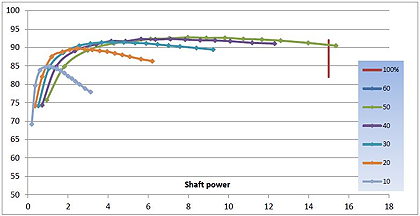The motors being tested were used to drive a pump operating with a constant pressure, from idling to peak load. The induction motors were run with and without drives, at six frequencies from 10–60Hz. The synchronous reluctance motor – an ABB SynRM model – operated with a dedicated drive.
The PM motor – a Leroy-Somer Dyneo LSRPM machine, tested with Control Techniques and ABB VSDs – was found to use almost 5,700kWh less over the course of a year than the IE0 motor. The Swedish Energy Agency points out that this saving is similar to the amount of electricity used by a typical Swedish four-person household over the course of a year.
The annual saving with the SynRM motor and drive was 4,285kWh, compared to the IE0 machine.

Effiency curves (%) for a Leroy-Somer PM motor driven by a Control Techniques VSD at different shaft power ratings (kW)Graph: Swedish Energy Agency
For the IE2 induction motor – a Lönne machine tested with ABB and Yaskawa inverters – the annual saving was 2,336kWh, while for the IE3 motor – a VEM machine tested with the same VSDs – the saving was 1,703kWh.
Commenting on the results, Emerson (which owns Leroy-Somer and Control Techniques) says that they show that its PM motor was the equivalent of one IE class more efficient than the rival products, and close to three IE classes more efficient than the IE3 induction motor used in the tests. Emerson adds that in a compressor application, the PM efficiencies would be even higher because these motors retain their efficiencies across the entire speed and load ranges.

